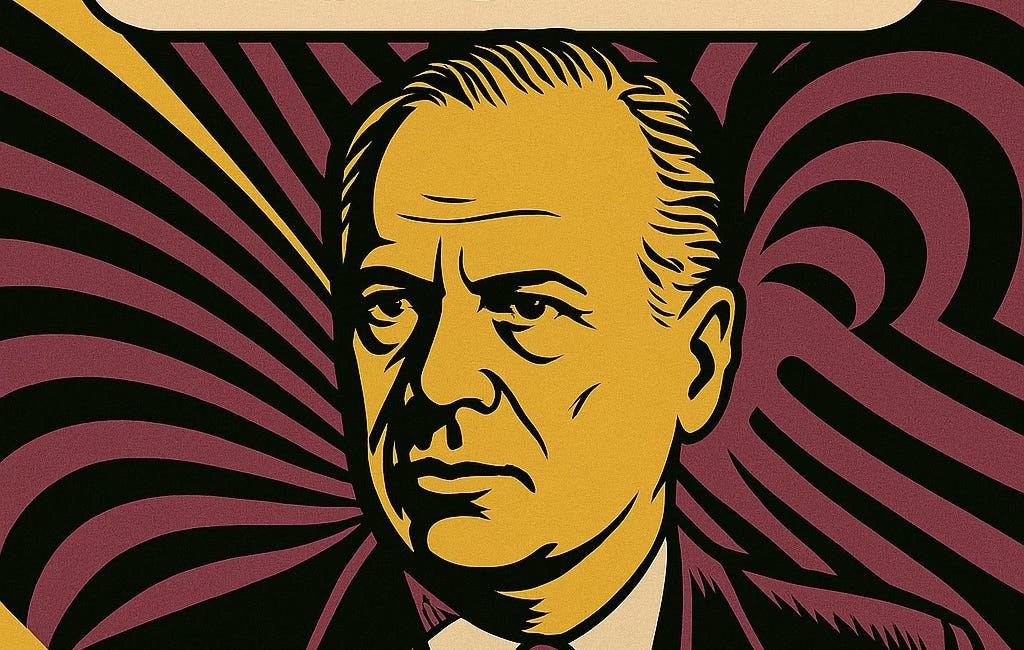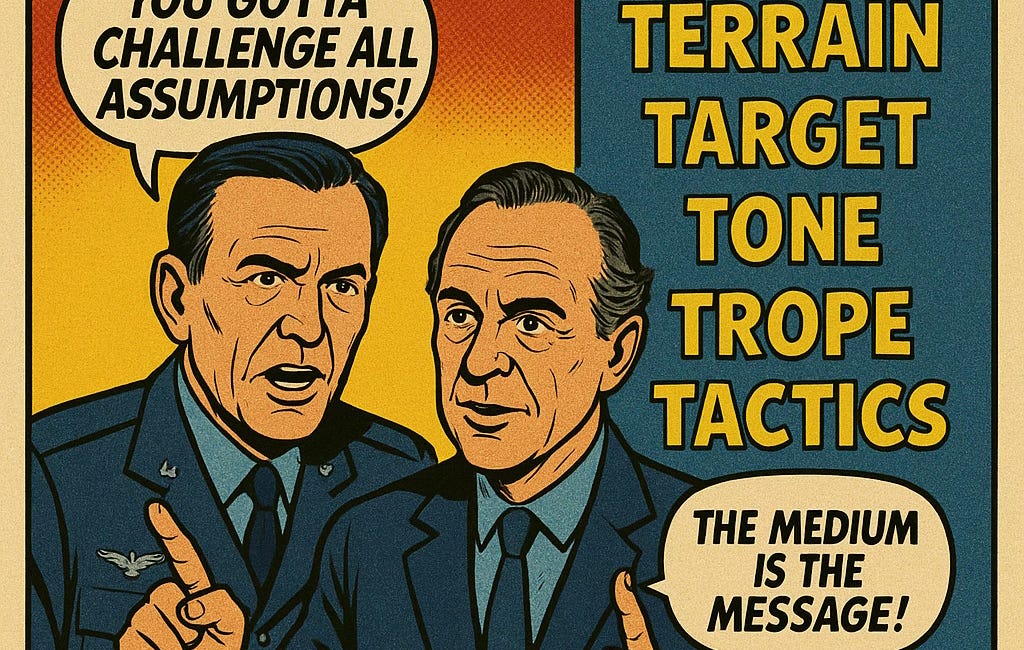THE PLAYBOY INTERVIEW THAT EXPLAINS MARSHALL McLUHAN BETTER THAN ANY BOOK
Discover why this 1969 Q&A is still the clearest, fastest way to understand “the medium is the message” and see your world differently.
“I read it for the articles!”
Everyone born before 1990 knows the joke. Playboy was bought for “the articles.” The excuse was always the same: “I only read it for the articles.”
And in March 1969, that excuse was no longer valid. Playboy published an interview with Marshall McLuhan that remains the best single entry point into his thinking. If you want to learn McLuhan, this is where you start. Not Understanding Media. Not The Gutenberg Galaxy. You start here.
Why? Because the interview strips away the fog. Instead of aphorisms, you get McLuhan locked into dialogue, explaining, clarifying, and tossing predictions that still sting half a century later.
Why an Interview Works
The form itself is the lesson. An interview is a cool medium with a low definition and high participation. You have to fill in the gaps, connect the lines, and argue with him. That’s why McLuhan comes alive here. You’re not just reading him, you’re practicing his method.
Inside the interview, you’ll find a compact map of his essential ideas, concepts that, once you get them, will change how you see everything from your phone to your politics.
McLuhan’s Probes in Playboy
The Medium is the Message – Content is the shiny object, and the real action is in the Medium itself. A text, a tweet, a livestream, all of these shape your attention, habits, and even your sense of time. It’s the form, not the story, that rewires you.
Extensions of Man – Every technology is an extension of a human faculty. A wheel extends your feet. A book extends your eyes. Today, your smartphone extends your memory and nervous system. These technologies aren’t outside you; they’re fused into you.
Narcissus Narcosis – Narcissus didn’t fall in love with his reflection because he thought it was someone else. He was numb to the fact that it was him. We do the same. We don’t see how deeply we’re shaped by the tech environments we exist in, scrolling, streaming, swiping, because they anesthetize us.
The Rear-View Mirror – We understand new environments by romanticizing the old ones. That’s why every generation says, “Things were simpler back then in the Good Ol’ Days.” We can’t see the new world forming, so we retreat into nostalgia.
Hot vs. Cool Media – Hot media fill in all the details, demanding little from us. Cool media require our participation. A photo is hot, a cartoon is cool. Today, TikTok is hot; group chat is cool. Notice how each pulls a different kind of effort out of us.
Retribalization & the Global Village – Electronic media don’t unite us into one big happy family. They collapse distance and force us into intimate proximity. That means more conflict as well as more connection. Sound familiar? Observe how politics unfolds online.
The End of Literacy’s Reign – Print made us linear, fragmented, and specialized. Electronic media reverses that, pulling us back into simultaneous, resonant “acoustic space.” That’s why you feel tugged in ten directions at once online. It’s not about books anymore, it’s about constant resonance.
The Fracturing of the Nation-State – Big, consolidated states are a product of print and centralized communication. Electric media decentralize power, splintering nations into tribes, identities, and ministates. Watch your news feed. You can already see the fragmentation. It’s accelerating.
Read that list again and notice how much of your daily life is already captured in it. Consider your social media feeds, your workplace, your family, and your sense of time. McLuhan saw it before astronauts set foot on the Moon.
The Irony of the Medium
And here’s the irony: this master key to McLuhan’s thought wasn’t published in a peer-reviewed academic journal. It was published in Playboy. A magazine dismissed as porn was also a cultural probe. Sex, consumerism, satire, and intellectual prestige are all bundled together. We mentioned the old joke was “I only read it for the articles.” With this McLuhan interview in the pages, that was a legitimate answer.
How to Use It
Think of the Playboy interview as your shortcut. It won’t replace Understanding Media. McLuhan’s magnum opus is still required here at The Whirl. And the Playboy interview will cut the learning curve in half.
Don’t just skim it online. Print it. Sit with it. Mark it up. Argue with it. Ask yourself:
What’s the Medium here?
What environment and technology are shaping me?
What am I blind to because I’m standing inside it as a participant and not outside as an observer?
This isn’t a textbook you study. It’s a set of lenses you try on until they change your vision.
Why It Matters
Here’s the value: one of the most challenging thinkers of the twentieth century left his clearest map not in a book, but in a magazine most people dismissed. That’s not an accident, it’s the lesson itself.
If you want McLuhan to be usable, not just quotable, this is the place to begin.
The most effective and competitive leaders and operators will print it, argue with it, and let it rewire the way they perceive the world.
You’re in a War You Can’t See: McLuhan, Media, and the Machinery of Perception
Want to win the war you’re already in? Subscribe here.
5GW Is Here: The One Protocol That Lets You See the War Before It Hits You
CHOOSE SIGNAL OVER NOISE.
Narrative Weapons Are Being Used Against You; This 5-Part Framework Shows You How to Identify Them And Fight Back
Don’t Just Keep Up. Outmaneuver. Subscribe.







Took me a good two hours to read this today. Partially because my attention span is trashed by YouTube, partially because this reads as much from 2025, as it was from 1969.
Especially in how he frames technology as extending our specific senses, and our senses fundamentally frame our linear, logical world in opposition to the oral, tribal world of the past.
How would Mcluhan view today's fight about AI? Would it be a hot media, or a diversion for the disintegration electric media overall is conducting?
Great reading. For a bit of fun I asked an LLM to continue the interview in current context looking at current mediums e.g. short form text and vertical video social media. Imagined McLuhan:
"What you describe are not “developments” but accelerants — intensifiers of the electric implosion I spoke of. TikTok is television inverted: not a cool mosaic viewed passively in the living room, but a pocket-sized tribal drum that pounds in your hand. It is low-definition in form but high-definition in frequency, saturating the nervous system with micro-bursts of gesture, rhythm, and mimicry. Twitter, now X, is the phonetic alphabet in its most compressed form: language stripped to sparks, tribal signals flung into the void. Together, they create an environment of perpetual resonance — a global village square in which every shout echoes instantly, with no walls to contain it."
"The message of the compressed tweet is simultaneity: the collapse of discourse into signals, a retribal drumbeat of affirmation or outrage. Content is irrelevant; the true message is that we live in a perpetual agora, a market of identities auctioned second by second."